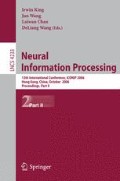Abstract
This paper describes an evidence-theoretic classifier which employs global k-means algorithm as the clustering method. The classifier is based on the Dempster-Shafer rule of evidence in the form of Basic Belief Assignment (BBA). This theory combines the evidence obtained from the reference patterns to yield a new BBA. Global k-means is selected as the clustering algorithm as it can overcomes the limitation on k-means clustering algorithm whose performance depends heavily on initial starting conditions selected randomly and requires the number of clusters to be specified before using the algorithm. By testing the classifier on the medical diagnosis benchmark data, iris data and Westland vibration data, one can conclude classifier that uses global k-means clustering algorithm has higher accuracy when compared to the classifier that uses k-means clustering algorithm.
Access this chapter
Tax calculation will be finalised at checkout
Purchases are for personal use only
Preview
Unable to display preview. Download preview PDF.
References
Loo, C.K., Rao, M.V.C.: Accurate and reliable diagnosis and classification using probabilistic ensemble Simplified Fuzzy Artmap. IEEE Transactions on Knowledge and Data Engineering 17(11) (2005)
Ross, T.J.: Fuzzy Logic with Engineering Applications. John Wiley & Sons, Chichester
Likas, A., Vlassis, N., Verbeek, J.J.: The global k-means clustering algorithm. Pattern recognition 36, 451–461 (2003)
Denoeux, T.: A neural network classifier based on Dempster-Shafer theory. IEEE Transaction on systems. MAN and Cbernetics-Part A: Dydtem and Humans 30(2) (2000)
Zouhal, L.M., Denoeux, T.: An evidence-theoretic k-NN rule with parameter optimization. IEEE Transaction on systems, MAN and Cybernetics-Part C: Applications and Reviews 28(2) (1998)
Shafer, G.: A mathematical theory of evidence. Princeton Univ. Press, Princeton (1976)
Denoeux, T.: A k-nearest neighbor classification rule based on Dempster-Shafer theory. IEEE Trans. Syst., Man, Cybern. 25, 804–813 (1995)
Lozano, J.A., Pena, J.M., Larranaga, P.: An empirical comparison of four initialization methods for the K-means algorithm. Pattern Recognition letters 20, 77–87 (2002)
Khan, S.S., Ahmad, A.: Cluster center initialization algorithm for K-means clustering. Pattern recognition letters 25, 1293–1302 (2004)
Wu, H., Diegel, M., Stiefelhagen, R., Yang, J.: Sensor fusion using Dempster-Shafer theory. In: IEEE Instrumentation and Measurement Technology Conference (2002)
Le Hegarat-Mascle, S., Richard, D., Ottle, C.: Multi-scale data fusion using Dempster Shafer Evidence theory. Integrated Computer-Aided Engineering 10, 9–22 (2003)
MacQueen, J.B.: Some methods for classification and analysis of multi variate Observations. In: Proceedings of 5th Berkeley Symposium on Mathematical Statistics and Probability, vol. 1, pp. 281–297. University of California Press, Berkeley (1967)
Yen, G.G., Meesad, P.: An effective neuro-fuzzy paradigm for machinery condition health monitoring. IEEE Transactions on systems, MAN and Cybernetics-Part B: Cybernetics 31(4) (2001)
Author information
Authors and Affiliations
Editor information
Editors and Affiliations
Rights and permissions
Copyright information
© 2006 Springer-Verlag Berlin Heidelberg
About this paper
Cite this paper
Poh, C.L., Kiong, L.C., Rao, M.V.C. (2006). Autonomous and Deterministic Clustering for Evidence-Theoretic Classifier. In: King, I., Wang, J., Chan, LW., Wang, D. (eds) Neural Information Processing. ICONIP 2006. Lecture Notes in Computer Science, vol 4233. Springer, Berlin, Heidelberg. https://doi.org/10.1007/11893257_8
Download citation
DOI: https://doi.org/10.1007/11893257_8
Publisher Name: Springer, Berlin, Heidelberg
Print ISBN: 978-3-540-46481-5
Online ISBN: 978-3-540-46482-2
eBook Packages: Computer ScienceComputer Science (R0)

